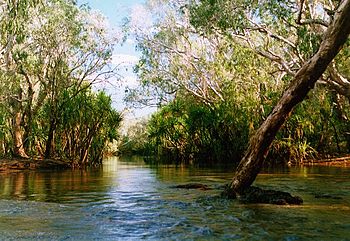Goyder River facts for kids
Quick facts for kids Goyder |
|
|---|---|

Goyder River Crossing
|
|
|
Location of the Goyder River mouth in the Northern Territory
|
|
| Country | Australia |
| Territory | Northern Territory |
| Physical characteristics | |
| Main source | Mitchell Ranges Arnhem Land, Australia 63 m (207 ft) |
| River mouth | Glyde river Arnhem Land, Australia 1 m (3 ft 3 in) 12°28′58″S 134°57′58″E / 12.48278°S 134.96611°E |
| Length | 171 km (106 mi) |
| Basin features | |
| Basin size | 10,391 km2 (4,012 sq mi) |
| Tributaries |
|
The Goyder River is an important river located in the Northern Territory of Australia. It flows through a beautiful and wild area called Arnhem Land. The river is named after George Goyder, who was a famous surveyor in South Australia.
Contents
About the Goyder River
The Goyder River begins in the Mitchell Ranges. It gets its water from underground springs that flow through a type of rock called dolomite. This water helps lush rainforests grow along the river's banks.
The river flows northwest, then turns north. It crosses the Central Arnhem Road. As it continues, the river splits into many smaller channels. These channels feed into a large wetland area called the Arafura Swamp.
Eventually, the Goyder River flows into the Glyde River. The Glyde River then empties into Castlereagh Bay and finally into the Arafura Sea.
The Arafura Swamp
The Arafura Swamp is a very important wetland. It covers about 700 square kilometers (270 square miles) during the dry season. This area is very special to the Yolngu people, who are the traditional owners of this land. The Ramingining community is located right on the edge of this swamp.
River Size and Flow
The area that collects water for the Goyder River is about 10,391 square kilometers (4,012 square miles). This area is surrounded by other river systems like the Blyth River and the Roper River.
Three smaller rivers, called tributaries, flow into the Goyder River. These are Annie Creek, Sheridan Creek, and the Gulbuwangay River.
The Goyder River is the ninth largest river system in the Northern Territory. It has a strong flow, especially at the end of the dry season.
Amazing River Animals
The Goyder River is home to many different kinds of animals. There are at least 39 species of fish living in its waters!
Some of the fish you might find include:
- Macleay's Glassfish
- Barred Grunter
- Fly-specked Hardyhead
- Freshwater Sole
- Golden Goby
- Northern Trout Gudgeon
- Gulf Saratoga
- Barramundi (a very popular fish!)
- Oxeye Herring
- Rainbowfish
- Black-banded Rainbowfish
- Bony Bream
- Salmon Catfish
- Berney's Catfish
- Freshwater Longtom
- Seven-spot Archerfish (known for spitting water to catch insects!)
- Sleepy Cod
History of the Area
The land around the Goyder River has been home to Indigenous peoples for thousands of years. The traditional owners of this area are the Dalabon, Daikui, and Djinba peoples.
Naming the River
The Goyder River was likely named in 1868. Captain Francis Cadell explored the area on his ship, HMS Firefly. He named the river after George Goyder, who was the Surveyor General of South Australia at that time.
Another explorer, David Lindsay, named the Glyde Inlet in 1883. He was on an expedition in Arnhem Land.
Early Cattle Stations
In the 1880s, the MacCartney family tried to start a cattle station called Florida. However, they faced many challenges and had to leave the station in 1893.
Later, in 1903, the Arafura cattle station was set up. It covered a huge area of 50,000 square kilometers (19,000 square miles) along the Goyder and Glyde Rivers. A man named Joseph Bradshaw brought 5,000 cattle to stock the station. But after five years, this station was also abandoned.


